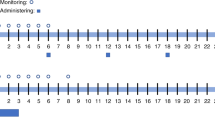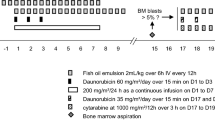Abstract
Propylene Glycol-Free melphalan HCL for Injection (PGF-Mel) is a new formulation that incorporates Captisol, a specially modified cyclodextrin, to improve melphalan stability. In this phase IIa, open-label, randomized, cross-over design bioequivalence study, the pharmacokinetics of PGF-Mel were compared with the marketed formulation of melphalan, or Alkeran. Patients received half of the total dose of melphalan in the form of Alkeran and the other half in the form of PGF-Mel in an alternating manner. The pharmacokinetic measures were determined using WinNonlin 6.2 and bioequivalence was assessed using log-transformed systemic exposure parameters. Twenty-four patients, 11 females and 13 males, were enrolled between 4 February 2010 and 16 May 2011 at The University of Kansas Medical Center and The University of Kansas Cancer Center. The median age of enrolled subjects was 58 years (range: 48–65). All patients achieved myeloablation 3 days post autologous graft followed by successful neutrophil engraftment with a median of 11 days after transplant. Pharmacokinetic analysis showed that PGF-Mel was bioequivalent with Alkeran and also revealed that maximum plasma concentration (Cmax) and area under the plasma concentration−time curve (AUC) were higher (~10%) after PGF-Mel administration. In conclusion, PGF-Mel is considered bioequivalent to Alkeran while also demonstrating a marginally higher systemic drug exposure.
This is a preview of subscription content, access via your institution
Access options
Subscribe to this journal
Receive 12 print issues and online access
$259.00 per year
only $21.58 per issue
Buy this article
- Purchase on Springer Link
- Instant access to full article PDF
Prices may be subject to local taxes which are calculated during checkout

Similar content being viewed by others
References
Cavo M, Rajkumar SV, Palumbo A, Moreau P, Orlowski R, Blade J et al. International Myeloma Working Group consensus approach to the treatment of multiple myeloma patients who are candidates for autologous stem cell transplantation. Blood 2011; 117: 6063–6073.
Moreau P, Facon T, Attal M, Hulin C, Michallet M, Maloisel F et al. Comparison of 200 mg/m(2) melphalan and 8 Gy total body irradiation plus 140 mg/m(2) melphalan as conditioning regimens for peripheral blood stem cell transplantation in patients with newly diagnosed multiple myeloma: final analysis of the Intergroupe Francophone du Myelome 9502 randomized trial. Blood 2002; 99: 731–735.
Child JA, Morgan GJ, Davies FE, Owen RG, Bell SE, Hawkins K et al. High-dose chemotherapy with hematopoietic stem-cell rescue for multiple myeloma. New Engl J Med 2003; 348: 1875–1883.
Zar T, Graeber C, Perazella MA . Recognition, treatment, and prevention of propylene glycol toxicity. Semin Dial 2007; 20: 217–219.
Wilson KC, Reardon C, Theodore AC, Farber HW . Propylene glycol toxicity: a severe iatrogenic illness in ICU patients receiving IV benzodiazepines: a case series and prospective, observational pilot study. Chest 2005; 128: 1674–1681.
Yaucher NE, Fish JT, Smith HW, Wells JA . Propylene glycol-associated renal toxicity from lorazepam infusion. Pharmacotherapy 2003; 23: 1094–1099.
Fu Y-H, Kim M-Y, Ray G, Liu Y, Pipkin JD . A sensitive LC-MS/MS method for determination of Melphalan in human plasma. J Clin Pharmacol 2011; 51: 1352.
Vesole DH, Crowley JJ, Catchatourian R, Stiff PJ, Johnson DB, Cromer J et al. High-dose melphalan with autotransplantation for refractory multiple myeloma: results of a Southwest Oncology Group phase II trial. J Clin Oncol 1999; 17: 2173–2179.
Porrata LF, Adjei AA . The pharmacologic basis of high dose chemotherapy with haematopoietic stem cell support for solid tumours. Br J Cancer 2001; 85: 484–489.
Moreau P, Milpied N, Mahe B, Juge-Morineau N, Rapp MJ, Bataille R et al. Melphalan 220 mg/m2 followed by peripheral blood stem cell transplantation in 27 patients with advanced multiple myeloma. Bone Marrow Transplant 1999; 23: 1003–1006.
Olivieri A, Corvatta L, Montanari M, Brunori M, Offidani M, Ferretti GF et al. Paroxysmal atrial fibrillation after high-dose melphalan in five patients autotransplanted with blood progenitor cells. Bone Marrow Transplant 1998; 21: 1049–1053.
Leung N, Slezak JM, Bergstralh EJ, Dispenzieri A, Lacy MQ, Wolf RC et al. Acute renal insufficiency after high-dose melphalan in patients with primary systemic amyloidosis during stem cell transplantation. Am J Kidney Dis 2005; 45: 102–111.
Morshed KM, Jain SK, McMartin KE . Propylene glycol-mediated cell injury in a primary culture of human proximal tubule cells. Toxicol Sci 1998; 46: 410–417.
Acknowledgements
We would like to thank all of the patients who participated in this effort. Special thanks to the study coordinator Kelly Daniels and the data manager Karen Wolfe for their help in conducting the study. We would like to thank Yu-Hui (Ann) Fu and team at the KCAS Bioanalytical Services for plasma sample management and for melphalan plasma assays. We would also like to thank Kim Frieze (Beckloff Associates, Inc) and Gilad Gordon, MD (Medical Monitor) for reviewing the data and the final manuscript. OSA is a recipient of a research career award by the Office of Scholarly, Academic & Research Mentoring (OSARM) at his home institution, the University of Kansas Medical Center. Ligand Pharmaceuticals Incorporated (sponsor) received support from the Kansas Biosciences Authority for this collaboration with the University of Kansas Medical Center.
Author information
Authors and Affiliations
Corresponding author
Ethics declarations
Competing interests
JDP is employed by the sponsoring company Ligand Pharmaceuticals Incorporated, Lawrence, KS, USA, the remaining authors declare no conflict of interest.
Rights and permissions
About this article
Cite this article
Aljitawi, O., Ganguly, S., Abhyankar, S. et al. Phase IIa cross-over study of propylene glycol-free melphalan (LGD-353) and alkeran in multiple myeloma autologous transplantation. Bone Marrow Transplant 49, 1042–1045 (2014). https://doi.org/10.1038/bmt.2014.120
Received:
Revised:
Accepted:
Published:
Issue Date:
DOI: https://doi.org/10.1038/bmt.2014.120
This article is cited by
-
Population Pharmacokinetics of Melphalan in a Large Cohort of Autologous and Allogeneic Hematopoietic Cell Transplantation Recipients: Towards Individualized Dosing Regimens
Clinical Pharmacokinetics (2022)
-
Safety and efficacy of propylene glycol-free melphalan as conditioning in patients with AL amyloidosis undergoing stem cell transplantation
Bone Marrow Transplantation (2019)
-
Comparable outcomes using propylene glycol-free melphalan for autologous stem cell transplantation in multiple myeloma
Bone Marrow Transplantation (2019)
-
Pretransplant hemoglobin and creatinine clearance correlate with treatment-free survival after autologous stem cell transplantation for multiple myeloma
Bone Marrow Transplantation (2019)
-
Population Pharmacokinetics and Optimal Sampling Strategy for Model-Based Precision Dosing of Melphalan in Patients Undergoing Hematopoietic Stem Cell Transplantation
Clinical Pharmacokinetics (2018)



